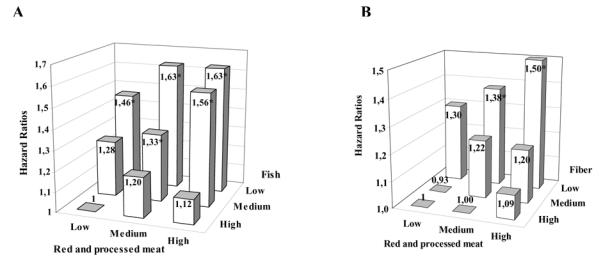Fig. 3.

Multivariable hazard ratios for colorectal cancer in the European Prospective Investigation into Cancer and Nutrition Cohort. Hazard ratios for intakes of A) red and processed meat and fish and B) red and processed meat and fiber. Multivariable analysis was performed using Cox regression models adjusted for age, sex, energy from nonfat sources (continuous variable), energy from fat sources (continuous variable), height (tertiles defined for each sex and center), weight (tertiles defined for each sex and center), work-related physical activity (no activity, sedentary, standing, manual, or heavy manual) smoking status (never, former, or current smoker), alcohol consumption (grams per day) and stratified by center. Low, medium, and high represent sex-specific tertiles. For red meat intake, low was less than 30 g/day of red and processed meat in men and less than 13 g/day in women, medium was 30–129 g/day in men and 13 to 85 g/day in women, and high was more than 129 g/day in men and 85 g/day in women. Cut points for fish intake were the same for men and women, with low being less than 14 g/day, medium being 14–50 g/day, and high being more than 50 g/day. For fiber intake, low was less than 17 g/day in men and women, medium was 17–28 g/day in men and 17–26 g/day in women, and high was more than 28 g/day in men and 26 g/day in women. * P <.05 relative to the group of subjects with low red and processed meat and high fish intake (A) or high fiber intake (B).
